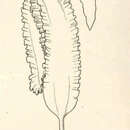Diagnostic Description
provided by FAO species catalogs
Thallus consisting of root-like holdfast, short stipe and blade. Blade long-belt shaped, up to one meter long, 10-20 cm broad, with margin undulate and overlapping, thick at the middle and thin at the margin. A short and small stipe and holdfast at the base of the blade. Holdfast sturdy (presenting haptera) with which the algae is fixed to rocky substratum. Colour: thick dark green; blade surface brown, occasionally glaucescent.
- Chi, M.H., Shi, S., Shuzhu P. & Zhang, Y. - 1963. Further studies on the comprehensive utilization of Laminaria japonica Aresch. Studia Marina . 3: 77-10.
- Ivin, V.V. - 1995. Fouling in Laminaria japonica mariculture. Proceedings of the International Conference on Ecological System Enhancement Technology for Aquatic Environments "ECOSET-95". Tokyo. 495-500.
- Kirihara, S., Notoya, M. & Aruga, Y. - 1989. Cultivation of Laminaria japonica at Hachinohe, Aomori Prefecture, Japan. Korean Journal of Phycology . 4: 199-206.
- Levring, T., H.A. Hoppe & O.J. Schmid - 1969. Marine Algae. A survey of Research and Utilization. Cram, De Gruyter and Co., Hamburg, Germany.
- Tseng, C.K., Liu, T.G., Jiang, B.Y., Zhang, Y.H. & Wu, C.Y. - 1963. Triglidae Study on the growth and development of Haidai (Laminaria japonica) transplanted at the Chekiang coast. Studia Marina Sinica. 3: 102-118.
Distribution
provided by FAO species catalogs
NW Pacific: Japan, Hokkaido, Korea, China, Coasts of Siberia (Levring et al., 1969). Mediterranean: France (accidentally introduced to Thau laggon together to other algae (Sargassum muticum and Undaria pinnatifida).
Size
provided by FAO species catalogs
Normal size to around 3 m.
Brief Summary
provided by FAO species catalogs
Seaweds of Laminaria japonica grows in subtidal areas from the upper infralittoral level.Sessile.Primary producer. Laminaria exhibit alternation of generations with heteromorphic (morphologically dissimilar) reproductive phases. The asexual diploid phase, the sporophyte, is of considerable size, while the gametophyte, the haploid dioecious phase, is microscopic. Sporophytes produce large numbers of haploid zoospores from sporangia (the called sori) situated on the blade. Zoospores develop into microscopic dioecious haploid gametophytes, male plants producing spermatozoid and female plants developing oogonia. Sori are produced all year round with maxima in July - August and November - December. Also, fragments of gametophytes may develop into new separate gametophytes. In winter, at the beginning of the vegetative period, a new thallus grows from the stipe while the old blade gradually dies. The gametophytes need low temperatures (and blue light) as optimal conditions to become fertile.
Benefits
provided by FAO species catalogs
In 1976 about 176,000 wet tonnes of Laminaria spp. were collected in Japan from wild sources and about 22,000 t were cultivated. Introduced from Japan, the intensive seaweed cultivation in China occurr since 1951. Harvest production: 62 tonnes (1952), reaching three million tonnes dry weight in 1998. Grazers (gastropod snails, amphipods), and diseases (some fungi) can cause great harms to cultivated kelp (the quantity of cultivated algae can lower up to 85%) (Ivin, 1995). Used frequently in Japanese cooking. It is used for making sweets and flavours to foods. Used as a medical drug in Southern China, and as a source of iodine in Russia. Usually sold in dried pieces and found in health food stores and Japanese groceries. L. japonica is collected from wild sources and also cultivated (Japan, Chinese coast). Cultivated in blasted areas of rocky shores or by seeding ropes.

